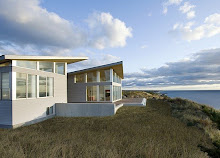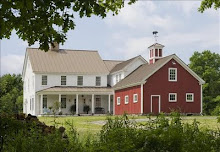 A hot plunge caldarium unearthed in ancient Roman bath house, heated by an under-floor hypocaust... a wonderful precursor to today's radiant heat.
A hot plunge caldarium unearthed in ancient Roman bath house, heated by an under-floor hypocaust... a wonderful precursor to today's radiant heat.Brrr.... time to share information on heating strategies employed in THE CONCORD GREEN HOME. As has been the approach with so many aspects of this special home, we considered both time-tested methods and the latest in modern technology.
 Unlike its hissing and clanking predecessors, modern Myson hot water radiators are highly efficient, and come in all different styles, including this vintage look selected for THE CONCORD GREEN HOME.
Unlike its hissing and clanking predecessors, modern Myson hot water radiators are highly efficient, and come in all different styles, including this vintage look selected for THE CONCORD GREEN HOME. Our ancestors had it right. Under-floor and hot water heating are thoroughly healthy ways to stay warm, whether in ancient Rome, or Victorian-era America.
The CONCORD GREEN HOME will have a mix of both radiant heat and radiators:
The first floor will have hydronic (hot water) radiant heat under its hardwood and stone flooring, which radiates warmth beautifully and keeps all surfaces free from visible heating elements. Many skeptics will tell you that radiant heat and hardwood flooring don't mix. There is some basis for that concern, as wood expands and contracts with temperature changes. However, if you use dimensionally stable species such as oak or maple, engineered wood flooring, or, in this case, old-growth quartersawn heart pine, it can absolutely be done.
Upstairs rooms will be warmed by hot water radiators from Myson in traditional style, as shown in photo above.
Boiler for hot water will be heated by gas, which feeds both the heating zones and the domestic hot water, which is stored in a 99% efficient tank. Plans and plumbing are in place to add solar thermal hot water heating soon. Hot water supply is divided into 6 lines - 2 for first floor heating, 2 for second floor heating, 1 for attic loft and 1 for domestic hot water. On demand, circulator pump "calls" for hot water from boiler and delivers to radiant or radiator zones as required. Pipes are upgraded to cast iron throughout the home --- we absolutely minimized use of PVC in this healthy environment.
A word about the ubiquitous use of forced hot air... I recognize that this may be controversial, but in my humble opinion, forced hot air, popular because it enables the inexpensive addition of air conditioning, is simply not an option for healthy heating.
Not only does forced hot air dry out the throat and nasal passages, leaving one more susceptible to illness, it makes any particulate, allergen, spore or chemical matter airborne, and then distributes it throughout the entire structure.
Lead paint dust, mold and other health risks common in the vast majority of older housing stock in this country are bad enough when heating is done by traditional methods, such as radiators, baseboards or wood stoves. The health risk is compounded exponentially when one then "modernizes" with forced hot air heating and cooling, and blows all those contaminants up into the air for easy inhalation. I am personally convinced that the introduction of forced hot air is one plausible explanation for the dramatic rise in asthma rates over the last few decades.
Ok, I'll climb down from my soapbox now.
While evaluating the best active heating system for your own home, be sure to do the following as well, to the greatest extent possible:
1. Optimize the house for passive solar heating, including orientation of the structure relative to the sun, window placement (including solar heat gain and efficiency ratings), thermal mass, etc. (See earlier posts on these topics)
2. Superinsulate the building envelope to minimize the impact of exterior temperature swings on interior comfort. Be sure to provide fresh air ventilation, preferably with heat recovery feature. (See earlier posts on superinsulation).
 It is critically important to keep the fresh air ventilation and heat recovery systems completely sealed until all construction work is 100% complete, in order to avoid contamination. Don't depend on a quick post-construction duct cleaning. Much better to prevent construction dust from entering in the first place.
It is critically important to keep the fresh air ventilation and heat recovery systems completely sealed until all construction work is 100% complete, in order to avoid contamination. Don't depend on a quick post-construction duct cleaning. Much better to prevent construction dust from entering in the first place.For more on the evolution of heating systems, check out Steve Smith's article, A Brief History of Radiant Heating, at Plumbing & Mechanical Magazine.


































There are many techniques to cool a house without air conditioning, but I only see them mentioned in alternative green building projects. Earth tubes, for instance, could be incorporated into any new construction. They use the ground's stable temperature for pre-heating or pre-cooling the air. We have a lot to learn in this respect.
ReplyDeleteYou are absolutely right, Gina. There are non-mechanical cooling strategies appropriate for every climate.
ReplyDeleteTHE CONCORD GREEN HOME will have no mechanical air conditioning installed, but rather rely on passive cooling strategies, such as large shady deciduous trees all along southern exposure, open staircase design for chimney effect cooling and careful window placement for cross-breezes throughout. Ceiling fans will also be installed in all main living spaces.
I couldn't agree with you more that we all have a lot to learn, from both new technologies, and those simple strategies of those who came before us.
Thank you for stopping by!
Lisa
Lisa - great, great addition to the blog. Would you have / be open to sharing any of the mfg. specifics of the system (boiler/furnace/heat recovery system, etc)? also, did you contemplate geothermal at any point? if so, did you do any cost analysis - i am trying to figure that out right now.
ReplyDeleteHi Tom.
ReplyDeleteThank you for your comment. Happy to know that the info is helpful. I will add specifics regarding mechanical systems in the next couple of days.
Geothermal would have been SIGNIFICANTLY more expensive in this location, and required more lead time.
Also, in the early planning stage, we had thought we were going to use electric radiant for ease and lower cost of installation, which is not compatible with geothermal. We ended up abandoning electric radiant due to concerns about adding such a huge electromagnetic frequency (EMF) load to a healthy house. Will post more on the health concerns regarding EMF at another date, but there is plenty of information online for those interested.
Lisa,
ReplyDeleteI have to say - this is super helpful because it is a real world, local case study. Thank you.
Tom
Glad to be of help. You mention that you are local. If you need more local resources, just let me know, as the team we have assembled on every aspect of the job, from the builder to each subcontractor that they have brought on, is top notch and in sync with our vision. If you do not have a builder in place, Aedi Construction obviously gets my vote!
ReplyDeleteLisa,
ReplyDeleteGreat post. Nice neat work on the radient manifolds and hot water piping.
Who did the work? Are they local?
Heating and cooling are 2 of the most important concepts of home ownership. In fact, heating and cooling systems are major factors for those looking to purchase homes, and are a critical part of living comfortably in a home.
ReplyDeleteThis comment has been removed by a blog administrator.
ReplyDeleteAlluring blog! Thanks for giving out this hearsay. It will be very constructive in regular part of life.
ReplyDeletePretty good post. I just stumbled upon your blog and wanted to say that I have really enjoyed reading your blog posts. Any way I’ll be
ReplyDeletesubscribing to your feed and I hope you post again soon.
This comment has been removed by a blog administrator.
ReplyDeletement and say that I really enjoyed reading your blog post here. It was very informative and I also digg the way you write! Keep it up and I’ll be back to read more in the future
ReplyDeleteThis comment has been removed by a blog administrator.
ReplyDeleteI like the writing structure of your blog and it does a pretty decent job of presenting the information
ReplyDeleteThis comment has been removed by a blog administrator.
ReplyDeleteThis comment has been removed by a blog administrator.
ReplyDeleteHello , I just stopped by to visit your weblog and thought I’d say thank you .
ReplyDeleteThis comment has been removed by a blog administrator.
ReplyDeleteI would like to start writing articles and post them like you do, but i just can’t decide which platform to use, between blogger and wordpress. Which 1 would u recommend for a newbie like me? By the way good articles you have!
ReplyDeleteThis comment has been removed by a blog administrator.
ReplyDeleteThere are certain things about the concept of rainwater harvesting that can sometimes be taken for granted, especially if you've been familiar with the process for a while. This was certainly the case for me while talking to a neighbour about rainwater tanks.
ReplyDeleteOne thing that I'd noticed over the last few years driving my car around Melbourne, Australia were the amount of houses that have Rainwater Tanks installed (and they're just the one's you can see from the street).
Awesome ! Thanks for sharing with us..
ReplyDeletePretty good post. I just stumbled upon your blog and wanted to say that I have really enjoyed reading your blog posts. Any way I’llbe subscribing to your feed and I hope you post again soon.
ReplyDelete